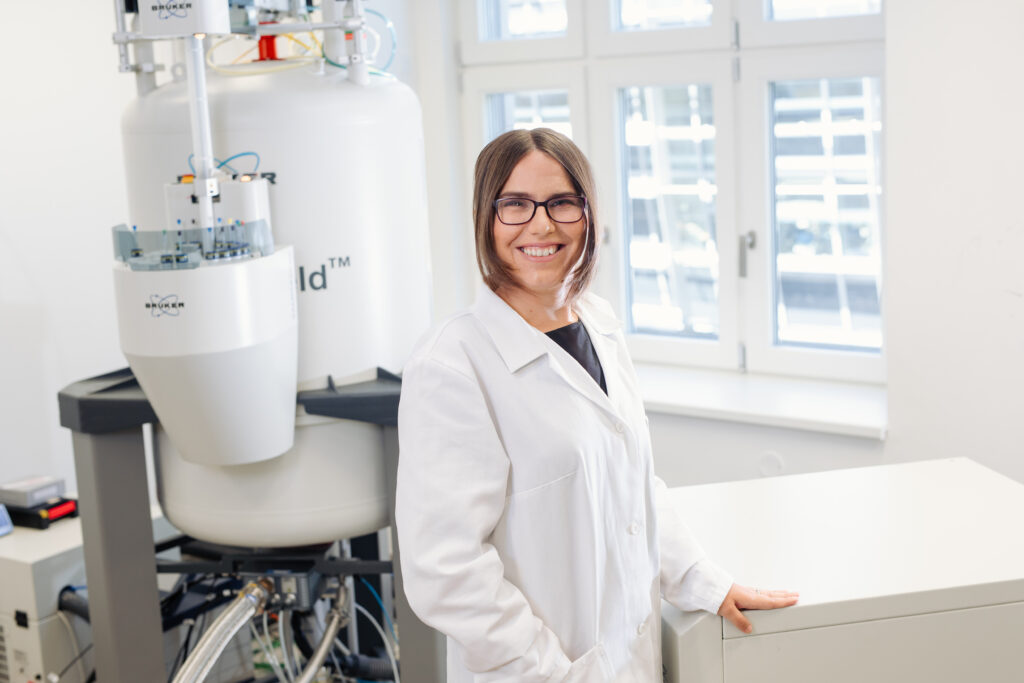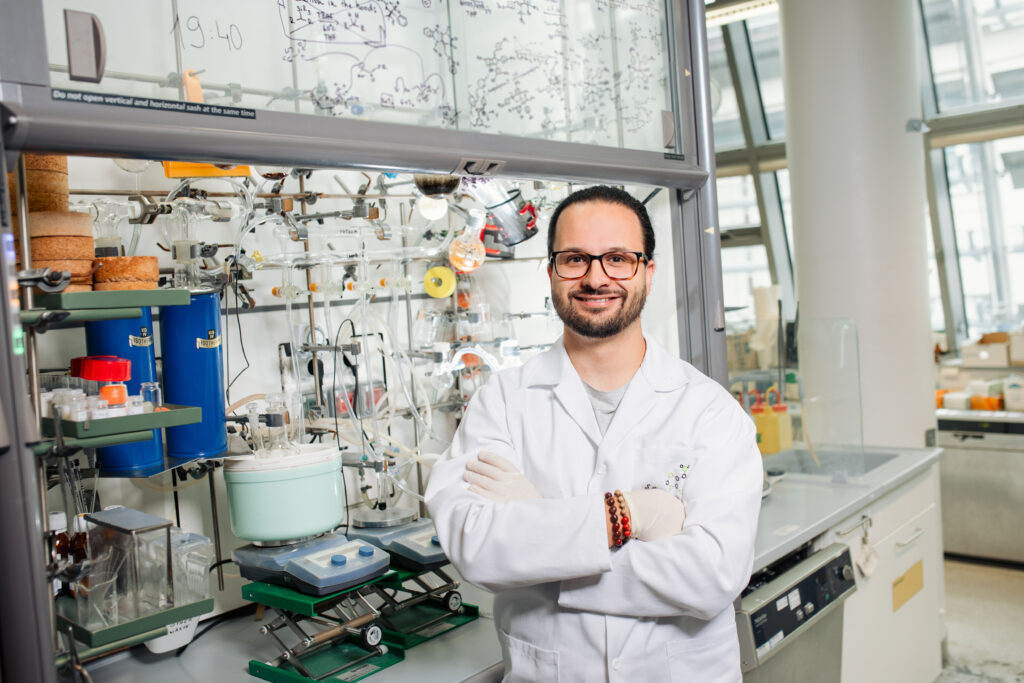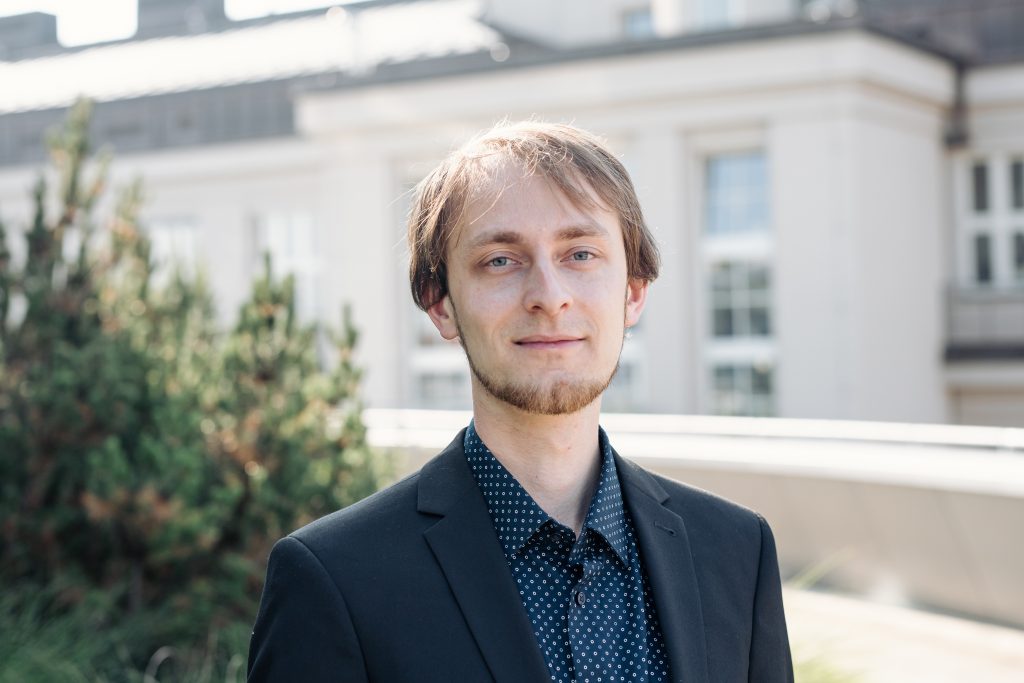We are trying to understand what causes synapse elimination in the brain
You applied for an Experientia Foundation grant with a project whose aim is to explain the mechanism of synapse elimination in the brain. How can we picture this process?
A synapse is like a contact through which neurons in the brain transmit information. Their elimination is a normal process that occurs every time you forget a piece of irrelevant information. The problem arises only at the moment when the synapse elimination occurs at an increased rate, for example in neurodegenerative diseases. Aschemical biologists, we investigate the biological questions (in this case, the elimination of synapses) using chemical methods. The chemical method, which we are developing, involves tagging proteins.
How does this protein tagging work?
Ideally, we should be able to choose a single protein in the body and transport a targeted chemical tag to it. This tag should bind to the protein and allow us to observe the protein under the microscope using fluorescence spectroscopy. We choose a substance which binds very tightly to the protein – typically a drug or research chemical. We thenbind a reactive chain and a fluorescent dye to this probe. The moment the reactive chain gets close to a protein, the reactive chain rearranges onto the protein,which then bears a fluorescent tag. The drug then releases itself from the protein and is metabolised. This way we get a tagged but fully functional protein that can bind to something else, such as other proteins. It is one of the challenges of chemical biology because until now, tags which bind directly to the site for the drug were primarily used. These tags make it impossible for another molecule to bind and the protein becomes partially or wholly inoperative.
In your research, you are exploring the role the specific protein integrin plays in synapse eliminationin the brain – what have you discovered?
Integrin ITG is a protein which is responsible for strengthening cells in an extracellular matrix, which is essentially a kind of scaffolding which holds cells together in tissue. In addition, we’re investigating the functions of the MFG (milk fat globule) E8 protein, which is a protein that has been isolated from milk and,in the immune system cells, it serves to identify those cells intended for elimination, which are subsequently absorbed by the cells of the immune system. This protein binds to integrin, and we assume that it is the interplay between these two proteins that could be responsible for the disintegration and elimination of synapses. The whole process is influenced by the immune system in the brain, specifically the glial cells – astrocytes or microglia. Using fluorescent tags, we wanted to examine this issue more closely.
How exactly did you conduct your research?
The first half of the project was to prepare tagging molecules using organic synthesis in which we prepared, isolated and analysed the substances. The objective of this phase was to use cost-effective commercial materials (mostly dyes) to prepare a drug, a reactive chain, and a fluorescent tag and to connect them all together to form a functional probe. This part of the project took us about nine months.
What stage are you in now?
Within the modelling experiments, we’ve so far prepared a drug with a non-reactive chain with a fluorescent tag. Now we’re testing how the probe affects cells. It works on the same binding site, which means that we can investigate whether or not we stop the function of the protein. At the same time, we can look at where the protein is present in the cell, and examine how it affects the absorption of other cells, and if the fluorescent tag binds to the protein the way we want it to or not. Furthermore, we will study how our two proteins interact in the area between the neurons and glial cells.
Why is it important to look at the brain at the molecular level?
It’s another perspective – we chemists offer slightly different information to that which biologists bring to the study of the brain. If we understand how synapse elimination in the brain works at the molecular level, we can influence this process. We can either speed up or slow down synapse elimination. If we knew how synapse elimination works and how proteins interact, we could design a drug that can slow the elimination of synapses. This is probably the most significant possible impact that our research could have.
What could your findings mean for the treatment of neurodegenerative diseases such as Alzheimer’s disease?
The problem with the research of Alzheimer’s or other neurodegenerative diseases is that no one knows precisely what causes them. Until now, one of the leading hypotheses for the onset of Alzheimer’s was the presence of amyloid plaques. People who have amyloid plaques, however, may not ever develop Alzheimer’s. The pharmaceutical industry has been trying to break down the plaques for nearly 30 years, but no progress has been made in the treatment of the disease. I’m not convinced that this is the right path. On the contrary –it is coming to light that synapse elimination is one of the main phenomena that precedes the onset of the disease. If we know with certainty what the real cause of the disease is, we can mitigate or stop it.
Are there any other potential uses for your method?
Definitely – our method is very general, and if it works, we can bind a probe to any protein in any organism and in this way essentially substitute the antibodies currently used to label proteins. Antibodies are naturally excellent tools that have made a lot of things possible. On the other hand, they also have their drawbacks, mainly that they are very variable. You buy an antibody one month that works well, and if you buy it half a year later, it won’t work at all, even if it’s from the same supplier. Antibodies are quite expensive – one dose costs about 500 dollars. In the case of buying antibodies, it’s a shot in the dark. Also, no one is sure of their specificity. Antibodies should be relatively selective, but often they’re not. The method we are developing is an alternative approach to the antibodies. If we can offer other options, that will probably be the most significant benefit of the entire research. We probably won’t cure Alzheimer’s, but if our chemical method works, there is a real chance that this method will overlap throughout biochemistry and medicine.
Why did you decide to specialise in this specific area of chemistry?
I have always been interested in organic chemistry; I like seeing things at a molecular level. Most of all, however, I’m interested in how the brain works. It is one of the most exciting challenges we face in this century. When I started doing organic chemistry, we worked on neurosteroids, which are essentially hormones in the brain. As a result, I gained some insight into how neurons communicate. Research into synapse elimination in the brain is a related area in which I can use my knowledge of organic synthesis and in which I can expand my knowledge of biology. I am particularly interested in how interneural communication works at the molecular level. In 2008, the immune system of the brain – glial cells – was discovered. This is an area that is experiencing a huge boom, and for me, it is a chance and a fantastic opportunity to get my foot into doors that are opening and to participate in this research.
Thanks to the Experientia Foundation grant, you went for a one-year stay in Prof. Menard’s research group at the University of British Columbia in Canada. What impressed you most about him?
It was primarily about the topic. He is engaged in an area on the cutting edge of current research. For me, it was a chance to work with my knowledge of chemistry in the field of biology. I also chose Prof. Menard’s group in British Columbia because there are excellent scientific facilities, beautiful nature, mountains, lots of vineyards…
What does Prof. Menard’s research team work on and what part of the research were you responsible for?
Prof. Menard’s group is relatively new – it was established in 2013. By the time I arrived, it had only been working for two years, so it can be said that I was one of the pioneers. Prof. Menard’s team consists of biologists and chemists. The chemists worked on the fluorescent dye and the development of the reactive chain. I was, however, the one that brought the concepts together. I had an advantage – I had already prepared a fluorescent tag at home, which I brought from the Czech Republic in my breast pocket, so I was able to finish my first tag within a few months. Now I work with the biologists. Because I’m a chemist, I’ve had to learn many new things, which is on one hand fun, but of course, it’s more time-consuming.
So in your research, you’re also working on biology?
Yes, I’m learning molecular biology, I prepare proteins, cells, and then observe them under a microscope and study how they work. I work on it together with a very helpful biologist friend, but I also carry out biological research myself.
How does the collaboration with Prof. Menard work? What system does he use and what was the most important thing you learned from him?
I am fascinated by what an excellent teacher he is. He has a very distinctive style and can explain things perfectly. That is something that I’m learning from him. It’s such an experience to talk with him about anything; his style of thinking is slightly different. Prof. Menard is very results-oriented. He’ll find a topic that could have an impact on related areas – in this case, the development of a chemical tag. Immediately after he comes up with an idea, he begins to enquire if it’s something that would be useful to other scientists or if it’s just a dead end, which will be useful only for us. If he concludes that the research could be useful to others, he runs with it and begins to build a network of cooperation between friends, acquaintances, and scientists from related fields and starts to promote the idea.
What were your impressions of the University of British Columbia? How is the scientific environment there different from the Czech one?
The scientific environment there seems more interconnected. The networks of contacts are far more extensive – not only in Canada but also in the United States, and there are many more opportunities for cooperation. Cooperation, however, does not only cross national borders but also the boundaries between disciplines. For some time now these borders have been blurring relatively quickly. Chemistry expands into biology, biology expands into chemistry, physics expands a little bit into everything, etc. And all these types of cooperation are extremely important.
What goals did you have for your research stay when you went?
In addition to the research goal, I aimed to learn as much possible, to try to comprehend the mentality of the local people, how people learn elsewhere in the world…
Do you have any publications on the horizon?
Yes, we are preparing an article on non-reactive tags, and I hope an article on reactive tags will soon follow.
Many grant recipients extended their stays abroad – you were one of them. What are you currently working on now in Canada?
I spent a year in Prof. Menard’s group thanks to the Experientia Foundation, and now I have a research position that Prof. Menard funds. I also teach organic chemistry, so the university partly pays me.
What is teaching at a Canadian university like?
Here they use the Anglo-Saxon system, which is different than the German system that the Czech system is based on. The Anglo-Saxon system places a greater emphasis on the development of individual critical thinking rather than memorisation, which has its pros and cons. During lectures, emphasis is placed on the details rather than the amount of data. They take one example and break it down to the smallest detail.
Was it difficult for you to adapt to this system?
Not really, it is quite natural, because critical thinking is essential in research. Even though I went through the Czech system, I learned the same things, but in a roundabout way. Yes, under Czech conditions, it takes longer, and one must absorb and understand on their own, but here students actively learn, so they reach the same stage of knowledge more quickly. However, they do not have the same depth of knowledge as Czech and German students.
What are your plans for the future?
I expect I will prolong my stay here for a little while and then begin to look for a position elsewhere. You can’t stay too long in one place. I will look for an entry-level teaching position in the Czech Republic or abroad. What I know for sure is that I want to focus on research.
Finally, can you say something about what the Experientia Foundation grant meant personally to you and how your internship advanced you career-wise and even personally?
It is an incredible opportunity. I especially appreciated the fact that I could choose what I wanted to do. I could expand the direction in which I originally wanted to go. Thanks to the research stay, I learned many new things – to understand biologists and try out what they do, what their problems are, but also to look at a problem from a chemical point of view. I also learned more about different ways of thinking and teaching.
What message would you give to potential Experientia Foundation grant applicants?
Firstly: Choose a topic that is not directly related to anything you have worked on before. Choose a type of research that you have no experience with, but that you’re interested in. It’s the easiest way and also your last chance to try new techniques, processes, and thinking, and yet still have a teacher/mentor. In the later stages of academic life, one must already be able to work on their own or with colleagues. With private financing, like that from the Experientia Foundation, it is much easier than if your boss has to pay you from his own grant and recalculate every dollar spent on results.
Secondly, a bit of practical advice: in addition to contacting the potential educational supervisor, I recommend also getting in touch with some students from their group to get a better idea of how things work there. This way you can identify a potential “bad mood” in the group. Some supervisors are notoriously well-known, so it is enough to contact someone at the same school in the same field.
I stuck to the first bit of advice, and it served me well; the second one I came up with in hindsight, but I got lucky, and it went well.
Vojtěch Kapras
Born in 1984 in Prague, Czech Republic. He received his master’s degree in organic chemistry from the Charles University Faculty of Science in Prague. After completing his PhD studies at the Institute of Organic Chemistry and Biochemistry of the Academy of Sciences of the Czech Republic in Prague, he received a grant of CZK 880,000 from the Experientia Foundation to pursue a postdoctoral research stay with Prof. Frederic Menard at Canada’s University of British Columbia. Thanks to the success of his project, Prof. Menard extended his stay in British Columbia for another year. Today Dr Kapras teaches organic chemistry at the University of British Columbia.
Nejvýznamnější publikace
Total Synthesis of ent-Pregnanolone Sulfate and Its Biological Investigation at the NMDA Receptor
Řekli o nás
Mgr. Ondřej Kováč, Ph.D.

Mgr. Dominik Madea, Ph.D.

Ing. Karolína Vaňková, Ph.D.
Mgr. Veronika Fialová




